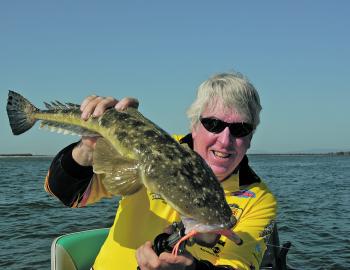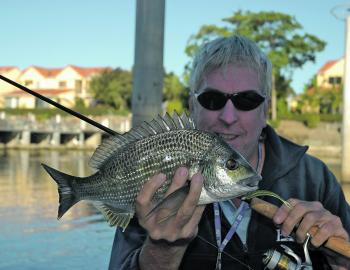Out on the continental shelf, the water temperature drops to around 23°C and the current slows down. Despite this, June can be a great month to chase blue and striped marlin. In past decades, many tournaments were held around June. Striped marlin tend to be more common and some monster blue marlin have been hooked in June.
Out further, on the thousand metre line, big schools of yellowfin tuna, some over 60kg, can turn up. There is also the odd wahoo and mahimahi. The days are often calm and now is definitely a good month to have a troll.
In closer to shore the bottom fishing improves as the water cools. Snapper and pearl perch increase in numbers on the 36 and 50 fathom reefs, and there are some big amberjacks and kingfish as well. Deep fished live baits can be a very effective option this month. The high pinnacles at the northern end of the 50 fathom line can fish very well in June, and also produce some big cod.
Cobia are another target this month on the closer reefs. The 18 and 20 fathom reefs east of the Seaway produce a lot of quality cobia in June, with quite a few 30kg monsters turning up. The secret is to constantly berley and work the berley trail using live baits and big soft plastics.
A deep live bait and one set mid-water are both effective. Cobia love big baits, and species such as tarwhine, goatfish and tailor are all very effective. Cobia are one of the hardest fighting species encountered off the Gold Coast, and a big one on light tackle can take well in excess of an hour to land. When fishing for cobia it pays to be patient. At times they move around in schools and they often turn up after several hours of constant berleying.
Mulloway are another option this month. The inshore reefs off the Seaway have produced increasing numbers of mulloway in recent years, and the best feed time is usually in the first hours of darkness. Live slimy mackerel and live pike are the best baits to use. Mulloway don’t seem to like yellowtail nearly as much. Tailor are another excellent bait, both live and as fresh fillets. The secret is to get well set up in your spot before dark, berley with chopped pilchards and be patient. Most bites come after sunset.
While the mackerel season drops off a lot in June, the remaining fish are generally big females, and there are still a few wahoo around as well. If you can catch small tuna or bonito, try slow trolling them over reef. The Tweed Nine Mile can produce some huge mackerel and wahoo in June, as well as some thumper yellowtail kingfish. June is very much a period of transition between summer and winter species, and there are plenty of offshore options to try.
The water cools and the fishing improves in June in the rivers and estuaries. This is the first month of the year to get really serious when it comes to your flathead fishing. While most of the fish are smaller specimens around 40-60cm long, there is the odd bigger fish. It will be interesting to see how fishing stickbaits up on the flats works this winter. This method produces a lot of big fish over 70cm in shallow water and may be the key to catching big winter flathead.
In general, casting plastics, vibes and metal blades will produce most of the fish. Trolling hardbodies is also very effective. Calm, clear days with light winds usually produce the best results. Trolling the flats on an early morning high tide can be particularly effective in June.
A lot of mullet start to move through the estuaries this month in preparation for spawning. These attract the attention of big mulloway. It’s a good month to start fishing high tide changes at night in the Seaway. Live mullet are the time-honoured reliable bait, and can generally be caught with a cast net along the Seaway walls. Live pike are another deadly option. Use around 15kg leader and position your bait so it sits in the eddy. It is a waiting game, but most of the mulloway caught at night are over a metre long. Every year a few in the 25kg bracket turn up.
The best times are generally towards the end of the month into July. Both the dark and full moons are fine, but on the dark moon phosphorescence can be a problem as it lights up your line and the fish can be very shy.
When you get a run, let the fish have a bit of line before striking hard. I generally use two 7/0 Octopus pattern hooks in my mullet. Some of our best spots are in the middle of daytime high traffic boat areas. Keep noise to a minimum, minimise lights and be quiet. These fish can be extremely cautious.
Large schools of bream turn up in the river entrances, the Seaway and Jumpinpin this month prior to the spawning run. These fall to soft plastics, small hardbodies and small vibes. Small live herring are often the best way to catch really big bream, with the odd fish over a kilo turning up. The area around the pipeline in the Seaway produces a lot of bream in June on both baits and deep fished plastics.
Sand crabs should still be around in good numbers, especially after the flood waters in early April. By June the effects of this fresh should have replenished the estuary quite well, and I think the fishing this month should be excellent. Tailor should also start to show in good numbers in the Broadwater this month on the run-in tides. Overall, June is an excellent time to fish the Gold Coast. There are plenty of options and the weather is great.
Reads: 2530
An awesome pair of whopper cobia.

A great Jumpinpin flathead.

The author caught this bream on a plastic.




